December 28, 2017
15-Year Integrated Forest Environment Education in Shimokawa, Hokkaido to Support Sustainable Forest Management
Keywords: Civil Society / Local Issues Ecosystems / Biodiversity Education Newsletter
JFS Newsletter No.184 (December 2017)
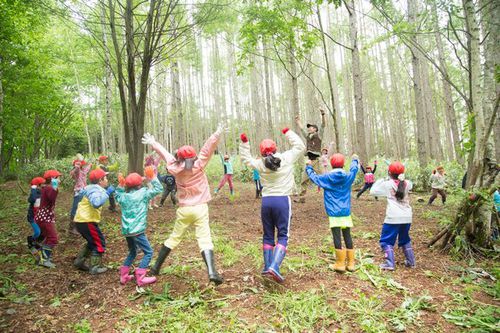
Copyright 2017 NPO Forest Life All Rights Reserved.
The last issue introduced the town of Shimokawa, Hokkaido, whose industrial promotion and regional energy supply were developed on the basis of its local forests. Years of efforts there bore fruit and starting from 2014, the trees planted by former generations have been cut down and seedlings planted in their place. This has enabled the town to implement recycling-based forest management and realize sustainable forest management. Based on its forest resources, the town has generated various new industries and the number of people moving there is increasing.
For Shimokawa, forests are an important resource for generating income, producing energy for industries and the local region and attracting people to move there. To protect these important forest resources, the town is also educating its people about forests. This issue of the JFS newsletter introduces a comprehensive forest environment education program targeting children from preschool to high school ages over a course of 15 years.
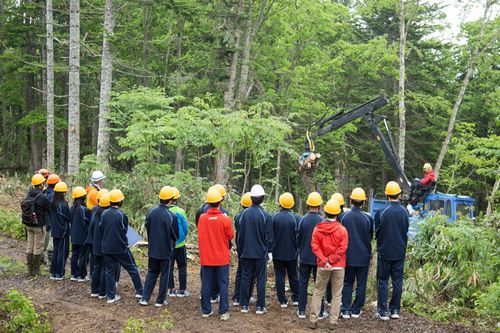
Copyright 2017 NPO Forest Life All Rights Reserved.
Background and Objectives
Shimokawa's forest environment education initiative started in fiscal 2006 with forest play programs targeting the Childhood Center's pupils. These were organized by the non-profit organization (NPO) Forest Life. Then, in fiscal 2007, the Shimokawa Town government started to hold its own forest experience programs for elementary, junior high and high school students in town. In fiscal 2009, to systematize these programs and make them more understandable, they were all consolidated into a forest environment educational system. In this way, a unified education was established on forest environments and provided to children attending the town's Childhood Center and its elementary, junior high and high school.
Since fiscal 2009, Forest Life has been running these programs as coordinator under contract with the Shimokawa Town government. We introduce the contents of these programs below, based on a report prepared by Forest Life.
Objectives of Forest Environment Education
The objectives of Shimokawa's forest environment education are as follows:
- To help children mature personally through learning in a familiar natural environment.
- To help children grow into individuals who can think about the environment on their own and take action to protect it.
- To help children understand regional forest-based industries.

Copyright 2017 NPO Forest Life All Rights Reserved.
15-Year Integrated Forest Environment Education Programs
Forest environment education is provided about once a month at the Childhood Center and once a year at the elementary, junior high and high school. The program for the elementary and junior high schools consists of three sessions: a pre-program classroom lesson, an actual on-site program in the forest and a post-program classroom lesson, which are incorporated into the school curriculum for a few days. At the high school, a more advanced forest environmental education is provided by, for example, using the school's forest.
The programs are organized and operated based on the Learning About Forests (LEAF) program, a forest environment education program that originated in Northern Europe. LEAF now operates in 26 countries. In Japan, the NPO FEE Japan is promoting the program.
LEAF's vision is to have children become aware of forests and learn that they play a key role in helping people's lives become sustainable. Under the philosophy of "Clever Question, Good Decision," the program, consists of participatory sessions centered around activities and adopts a practical approach to informing participants of the cultural, ecological, economic and social functions that forests fulfil so that they can learn about forests from a number of diverse, multilayered standpoints.
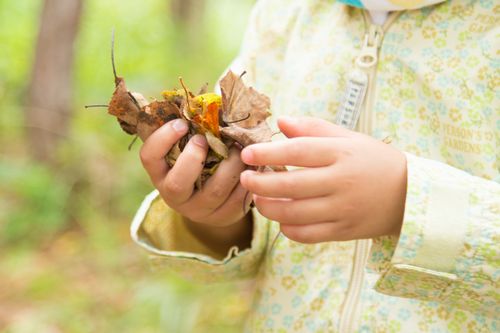
Copyright 2017 NPO Forest Life All Rights Reserved.
Specific Contents of the Six-step Program
Forest Life provided 27 programs to a total of 1,310 children in fiscal 2016. Below, we introduce the programs implemented that year. They were offered in accordance with the six steps of LEAF.
< STEP 1: Enjoy Playing Outdoors >
Shimokawa's Childhood Center -- Forest Play
April 21: Tasting white birch sap
May 17: Observing plants and flowers around them
May 19: Observing spring plants and learning their names
June 2: Spring family excursion (harvesting mugwort: an edible plant of the daisy family)
July 21: Observing leaves and flowers of trees and wildflowers
August 25: Finding summer creatures
September 1: Autumn family excursion (gathering fallen leaves and branches)
September 15: Enjoying roasting sweet potatoes
September 21: Harvesting acorns
October 5: Harvesting acorns, mushrooms and fallen leaves in the forest
December 15: Enjoying snow and finding traces of animals
January 25, 2017 (Walnut Class only): Making bookmarks using white birch bark (craftwork)
January 26 and February 9: Enjoying sled rides on a snowy hill
March 2: Closing ceremony (forest play slide show and presentation of certificates by the forest fairy)
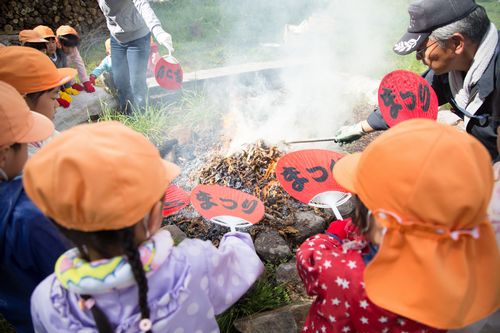
Copyright 2017 NPO Forest Life All Rights Reserved.
<STEP 2: Experience and Learn about Nature>
Shimokawa Elementary School
First grade students: Finding their favorite tree
- Cultivating a sense of attachment to nature in the local area through craftwork using familiar natural items as a motif.
Second grade students: Making their own tree guide book
- Promoting awareness of diversity of tree species and increased interest in and respect for forests by having the students make their own tree guide book.
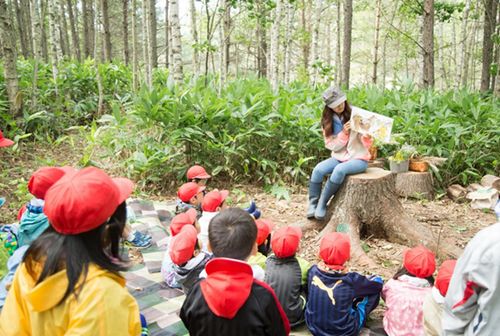
Copyright 2017 NPO Forest Life All Rights Reserved.
<STEP 3: Understand Environmental Mechanisms>
Shimokawa Elementary School
Third grade students: Studying the mechanisms at work in forests
- Deepening the students' understanding of the circulation mechanisms at work in forests by learning about the roles of insects, animals, mushrooms and trees.
Fourth grade students: Learning about forest development
- Increasing interest in and respect for tree planting and growing activities and understanding of the town's recycling-oriented forest management by participating in the Shimokawa Tree Planting Festival.
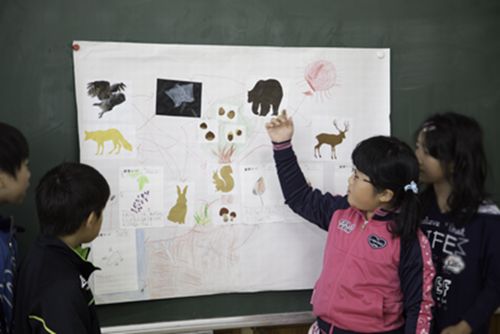
<STEP 4: Understand the Interaction between Humans and Nature>
Shimokawa Elementary School
Fifth grade students: Learning how to utilize wooden materials
- Increasing interest in and respect for the activities of people engaged in developing and utilizing forests and learning about the interaction between humans and nature by conducting a survey on forests, cutting trees and visiting factories and facilities that utilize timber from forest thinning.
Sixth grade students: Considering wooden products and our daily lives
- Learning more details about tree species and wooden materials, increasing interest in wooden products by having the students make their own chopsticks and considering choices that they can make in their daily lives.
<STEP 5: Make Individual Judgments on Environmental Issues>
Shimokawa Junior High School
First grade students: Orientation on learning through charcoal making
- Recognizing the relationship between themselves and the natural environment of Shimokawa, an environmental model town, and becoming able to take actions conscious of that relationship during a charcoal making experience.
- Understanding the history and methods of charcoal making.
Second grade students: Observing various kinds of forest work
- Learning about various kinds of forest work conducted in Shimokawa, an environmental model town, and considering their future careers and how to lead their lives through briefing sessions and work experiences.
Third grade students: Learning about, discovering and telling others about Shimokawa now
- Becoming aware of the positive environmental, industrial and historical aspects of their town by researching how forest resources are utilized in Shimokawa. Also, becoming aware of how the town needs to improve from an objective viewpoint.
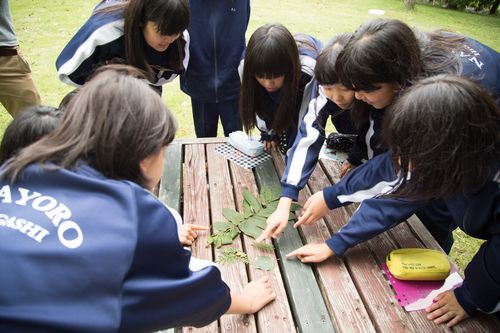
Copyright 2017 NPO Forest Life All Rights Reserved.
<STEP 6: Be Responsible for the Future>
Shimokawa Commercial High School
First grade students: Campus exchange program between Hokkaido Shimokawa Commercial High School and Hokkaido Shibetsu Shoun High School
- Deepening the students' understanding of Shimokawa Town's forest resource utilization initiatives.
- Strengthening student exchange between Shimokawa Commercial High School and Shibetsu Shoun High School.
Second grade students: Studying the economic value of forests and forest-related work in Shimokawa
- Deepening the students' understanding of the economic value of forests and having them consider careers related to forests and forestry.
Third grade students: Tree Planting Festival
- Increasing the students' interest in and respect for tree planting and growing activities and their understanding of the town's recycle-oriented forest management through participation in the Shimokawa Tree Planting Festival.
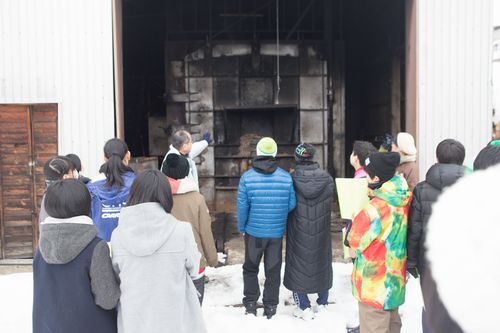
Copyright 2017 NPO Forest Life All Rights Reserved.
Activity Fields
As shown in the illustration below, activities are implemented at various sites in the town that serve as activity fields.
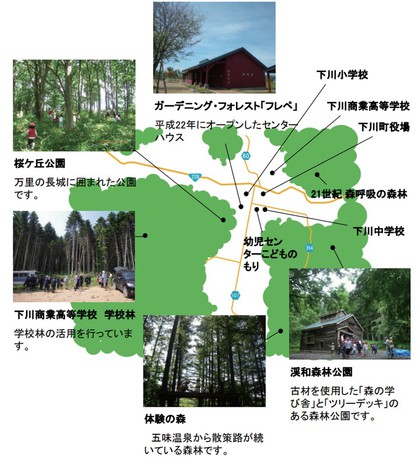
Copyright 2017 NPO Forest Life All Rights Reserved.
Cooperation with Schools
After carrying out the programs, Forest Life conducts a questionnaire survey of school teachers to improve the programs based on a quantitative assessment. It also holds a meeting of people involved in Shimokawa's forest environmental education twice a year to encourage relevant entities, such as educational institutions, the town's board of education and the town hall, to participate in the process of planning, assessing, and improving the forest environment education, so as to advance it under a cooperative structure.
Children's Reactions
We interviewed Tsubasa Aso, representative of Forest Life, about the reactions of children and their parents. The following are his remarks from the interview.
At the Childhood Center, I often hear of parents' comments like "Our children are really delighted to go to the center," and "When they come home, they say they enjoyed the activities there." Also, a mother told me that one day when she was walking with her child on the street, the child pointed at a weed and said, "Mom, you can eat this weed. Make me tempura with it!" The weed was mugwort. At the center, children pick mugwort leaves early every spring. That's why her child was able to distinguish that plant from other plants.
In an earlier survey, we asked children if they had seen a tree being cut down. More than 80 percent of children in Shimokawa answered yes, while in general only 30 percent of children would have answered affirmatively. Also, to the question of what they would like to be in the future, a sixth-year elementary school girl replied "a forest specialist." She looked into the occupation and presented it at her school's presentation meeting in front of the students' parents.
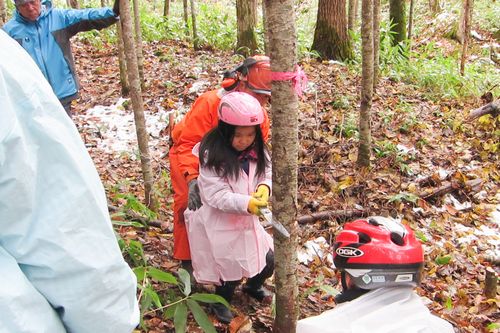
Copyright 2017 NPO Forest Life All Rights Reserved.
There was one more thing that made me happy. In the "Let's discover local treasures" class at the elementary school, second-year students discussed what they thought Shimokawa's treasure was. They were divided into six groups, and each group talked together and looked into the subject. After the discussion, three of the six groups concluded that Shimokawa's treasure was its forests and decided to investigate them.
So the teacher asked them, "To whom should you ask questions about the forest?" And the students answered "Forest Life." I was really glad to hear that. The students actually came to us and asked me questions they had prepared. The questions were interesting. For example, they asked, "How many trees are there in Shimokawa?" I replied, "Umm, I wonder how many..." (laughter)
His remarks assure us that forests have become more accessible and valuable to children.
Conclusion
As noted in the previous issue, Shimokawa is considered a model for the development of a sustainable municipality, in that it uses forests, which cover more than 90 percent of its area, in a sustainable manner to vitalize industry and attain self-sufficiency in energy. This issue also noted that to achieve this, Shimokawa is also making steady efforts to develop human resources.
In November 2017, Shimokawa Junior High School held a class for second year students about sustainable development goals (SDGs). They were divided into eight groups, and each group considered what kind of municipality they wanted Shimokawa to be in 2030. Each group selected three of the 17 SDGs as particularly important goals for the town and discussed the three goals. Of the eight groups, seven groups selected Goal 15 (Life on Land), showing that the importance of forests is firmly rooted even in junior high school students. When these children grow up, wouldn't it be exciting to see them develop the town further, using forests as a foundation for sustainability!
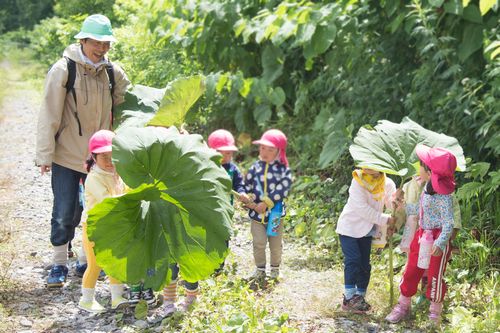
Copyright 2017 NPO Forest Life All Rights Reserved.
Written by Junko Edahiro
Related
"JFS Newsletter"
- 'Good Companies in Japan' (Article No.4): 'Eightfold Satisfaction' Management for Everyone's Happiness
- "Nai-Mono-Wa-Nai": Ama Town's Concept of Sufficiency and Message to the World
- 'Yumekaze' Wind Turbine Project Connects Metro Consumers and Regional Producers: Seikatsu Club Consumers' Co-operative
- Shaping Japan's Energy toward 2050 Participating in the Round Table for Studying Energy Situations
- 'Good Companies in Japan' (Article No.3): Seeking Ways to Develop Societal Contribution along with Core Businesses


